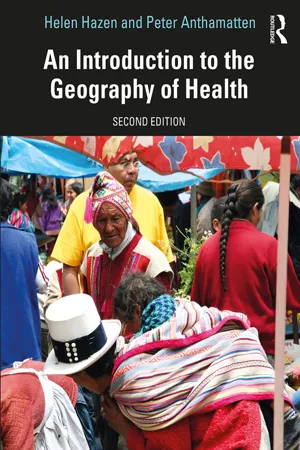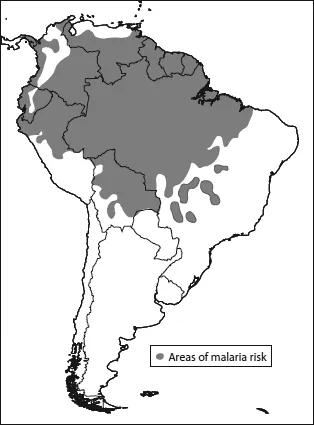In many ways, human health has never been better. Great strides have been made in reducing the prevalence of malnutrition and the incidence of infectious diseases such as polio, measles, and cholera. Rising incomes and targeted development efforts have led to improved access to healthcare, education, and other services, enabling many people to enjoy higher living standards than ever before. At the same time, efforts to improve public health through basic interventions such as sanitation and vaccination have greatly decreased infant mortality rates. As a result, life expectancies have been generally rising worldwide, even in low-income regions.
These improvements are inconsistent across global regions, however, with economic progress and attendant health improvements in some countries diverting attention away from continued economic and health challenges in many parts of the Global South (Box 1.1). In addition, there are stark divides within many countries between the newfound health and wealth of a rapidly growing middle class and the stagnation of health outcomes among poorer, often rural households. For example, while undernutrition is declining at the global scale, it remains a problem for many of the world’s poorest people. In 2018, an estimated 224 million children under age 5 were underweight or experienced growth deficiencies as a result of malnutrition and around 45 percent of deaths in this young age group were tied to nutritional deficiencies (WHO 2018). Pockets of undernutrition persist even in the world’s most affluent countries, as evidenced by the need for free food banks in wealthy countries such as the US, Australia, and the UK.
Box 1.1
THE GLOBAL NORTH AND GLOBAL SOUTH
Geographers, economists, and political scientists have long recognized the significance of economic development to many aspects of human society and have categorized the countries of the world to reflect these differences, using labels such as “First World,” “Third World,” “developed countries,” and “less-developed countries.” Increasingly, however, scholars and policymakers have become wary of the value judgments inherent in these comparative terms—for instance, the notion that developed countries have already succeeded is implicit in the term “developed,” with less-developed countries appearing wanting, by contrast. To address these concerns, many scholars today prefer the terms Global North and Global South. The Global North—including Western Europe, Canada, the US, Australia, New Zealand, and parts of East Asia—is recognized by its economic affluence, while the world’s remaining countries comprise the Global South and are characterized by their marginalized position in the global economy.
These categories reflect the significant impact of economic development on health, with the countries of the Global North traditionally having higher life expectancy, lower infant mortality, and lower fertility than the Global South. Health issues do not always neatly divide the Global North and South, however. In particular, parts of the Global South have made great strides in lowering infant mortality and fertility, while concurrently extending lifespans. Thailand, Lebanon, and Chile, for instance, have fertility rates similar to Western Europe, while lifespans in countries as diverse as Panama, Bahrain, and New Caledonia are comparable to the US (PRB 2019).
Another traditional distinction lies in the significance of infectious versus non-infectious disease, with the countries of the Global South tending to have higher rates of infectious disease than the North. By contrast, mortality in the Global North is largely associated with non-infectious diseases such as cancer and heart disease. Even here, the distinction is increasingly blurred, however, with the Westernization of lifestyles in the Global South leading to the rising incidence of non-infectious diseases, while certain infectious diseases appear to be making a comeback in the affluent North.
One further complication is that income inequalities within countries are often greater than those among countries, with affluent populations in the Global South often having very similar health outcomes to those living in the Global North. Furthermore, certain sub-populations in wealthy countries may actually have poorer health outcomes than Global South averages. For instance, Sri Lanka and the state of Kerala in India both report lower infant mortality rates than some minority populations in the United States. We therefore acknowledge the importance of terms like Global North and Global South in highlighting important trends, while recognizing the need to apply these terms judiciously.
At the other end of the spectrum, there has been a dramatic increase in so-called diseases of affluence, associated with the adoption of westernized lifestyles across the world, including in the Global South. As more people live sedentary lives with easy access to abundant processed food, rates of obesity and other chronic diseases such as cancer and heart disease are rapidly increasing across the globe. The Worldwatch Institute announced that there were more over-nourished than under-nourished people in the world for the first time in the year 2000 (Gardner and Halweil 2000), and this trend has continued. Many low- and middle-income countries are now experiencing a double burden of disease as their healthcare systems struggle to cope with both the traditional threats of malnutrition and infectious disease, as well as chronic conditions associated with Western lifestyles among increasingly affluent, urbanized, and sedentary populations.
Many countries of the Global North are also seeing a growing socioeconomic divide. As affluent populations see more people than ever before reach the age of 100, some poor and marginalized populations are actually experiencing declining life expectancies. Wealthy populations have traditionally experienced better health than the poor because of better living conditions and nutrition, as well as more time, better education, and more social capital. Today, the rich have maintained many of these benefits, while middle- and working-class communities often struggle with stresses associated with an increasingly competitive work environment related to processes of globalization. Poorer communities often have the resources to obtain abundant food and a sedentary lifestyle but may not have the time or means to invest in longer-term health goals, resulting in higher rates of lifestyle diseases such as obesity and diabetes. The stresses of daily life can become overwhelming for some, leading to destructive behaviors such as drug abuse, suicide, and alcoholism. The so-called deaths of despair associated with these behaviors have hit the US particularly hard, with drug overdose and suicide held responsible for much of a recent and unprecedented decline in life expectancy in the US (Case and Deaton 2015; AAFP 2019).
Such inequalities highlight the hierarchies of power that affect health at a variety of scales, from the household to the global. Why does a businessman in Brazil have a life expectancy of 80, while his maid’s is only 60? Why is a baby born to an African American woman in Chicago more likely to be born prematurely than a white baby born in the same community? Why is a head of household in northern Ghana well nourished while some of his children remain undernourished, or a girl in an urban slum in India less likely to be taken to a doctor than her brother? In all these cases, we must consider how individuals are embedded in a web of cultural, economic, and political structures that enable or constrain their ability to meet their health needs. For example, a poor farmer in Mali may be constrained in her ability to grow sufficient food to feed her family owing to competition for land from commercial peanut growers, her inability to borrow money as a woman, and increasingly sporadic rains. The proximate (immediate) cause of her children’s poor health is malnutrition—but social structures of society must be explored to fully understand the challenges her family faces. A study of these broader structural factors could consider patriarchal structures of the local community, government agricultural policies, Mali’s marginal position in the global economy, and even the global political and economic forces that have allowed climate change to continue unchecked to the point where it is now affecting rainfall patterns in Saharan Africa. Influences on health can thus be recognized at a variety of geographic scale, with potential points of intervention at all of them.
This scalar framework broadens our approach to understanding what drives health and disease, encouraging us to think beyond clinical solutions that target individuals. In particular, structural factors such as race, socioeconomic status, and political power are widely understood to be important influences on health and healthcare. These factors have long been recognized to act materially (e.g., poverty can lead to poor access to food or healthcare and thus poor health) but are increasingly understood to have measurable physiological effects associated with psycho-social factors such as the stress of experiencing discrimination. As our understanding of these connections grows, communities are exploring social and political approaches to tackling health problems that address structural factors. The United Nations’ identification of eight Millennium Development Goals in 2000 (to be achieved by 2015) and the Sustainable Development Goals of 2015 are illustrative of these efforts. While several of the goals address health issues directly—for example, reducing child mortality and improving maternal health—others aim to improve human well-being by addressing broad structural issues through strengthening institutions and reducing inequalities.
In an era of climate change and rapid landscape conversion, our world’s changing ecology also creates new challenges (Figure 1.1). Changes in climate, vegetation patterns, species distributions, and how humans interact with their environments—particularly as we move from rural to urban lifestyles—have profound implications for health. Ecological changes have been held at least partly responsible for a resurgence in some infectious diseases such as malaria and Lyme disease, as well as the emergence of some newly identified pathogens, including Ebola, HIV, and avian flu. In several countries in sub-Saharan Africa, life expectancies actually declined in the first part of the twentieth century (in some countries to under 40 years) as a result of the HIV/AIDS epidemic. Although the use of antiretroviral therapies for HIV infection has reversed this trend, it provides a timely reminder of the ever-present potential of infectious diseases to generate devastating pandemics.
Figure 1.1Clear-cutting, South Australia
What is the geography of health?
Just as the study of life is the focus of biology, geographers focus on the importance of space and place. With an emphasis on how and why things vary across space and how people interact with their physical and social environments, health geographers consider not only spatial patterns such as disease distributions but also how people’s health is influenced by their relationship with their physical and social environments. For example, health geographers might ask why malaria occurs only in certain parts of the world. What is it about the natural and built environments of these places that makes people vulnerable to malaria? How do human activities in these places influence vulnerability to malaria?
Many of these topics fall in the domain of public health. In contrast to clinical medicine, which focuses on the health of individuals, public health examines population-wide processes and emphasizes health-promoting behaviors that will benefit entire communities. Public health study often involves exploring how individuals interact with one another and their environment, and frequently places an emphasis on preventative health rather than curative approaches. Although health geography overlaps with public health research, the geography of health is distinct in its emphasis on space and place, grounding geographers in spatial questions. In addition, while public health research is often quantitative, many health geographers now consider experiential questions that demand qualitative research, such as why particular places make us feel as we do, or how a person’s position in society affects their health.
Figure 1.2Malaria risk in South America
Geographers acknowledge a clear distinction between space and place in their analyses. Space refers to where things are located, and so spatial questions consider factors such as distribution, direction, and connectivity. Place refers to a unique locale and its social significance from the values imbued by individuals and communities, often requiring more qualitative analyses. For instance, your house may be little more than a location to most people, but it has significance to you bec...


